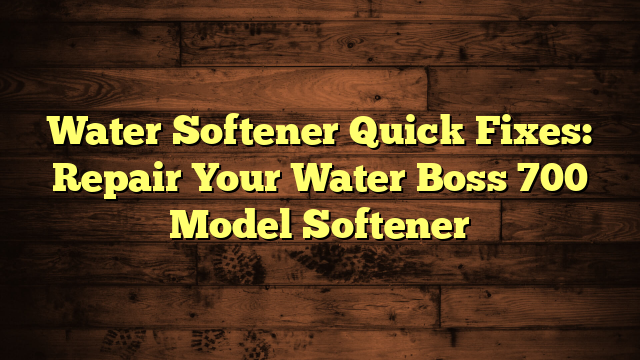How to Install a Water Softner Lines?
Installing water softener lines might seem intimidating, but it's a straightforward process that you can handle with the right tools and guidance. You'll want to start by gathering essential items like wrenches and Teflon tape, and confirming you choose a suitable location for your softener. Once you've turned off the main water supply, the real work begins—connecting the inlet and outlet lines correctly is vital. But how do you make sure everything is leak-proof and fully operational? Let's explore the steps together to make your installation smooth and effective.
Key Takeaways
- Gather essential tools and safety gear, including wrenches, screwdrivers, Teflon tape, and gloves before starting the installation.
- Turn off the main water supply and verify all faucets are inactive to prevent leaks during installation.
- Connect the water softener to the inlet and outlet, using Teflon tape on threaded connections to ensure a leak-proof seal.
- Install a drain line sloping downward towards a floor drain, ensuring all connections are secure to prevent leaks.
- Test the system for leaks and monitor operation for at least 30 minutes after installation to confirm proper functionality.
Gather Necessary Tools
Before diving into the installation process, you'll need to gather the necessary tools for setting up your water softener lines. Creating a thorough tools checklist is important to guarantee you have everything you need at your fingertips.
Start by collecting basic hand tools like a wrench, screwdriver, and pipe cutter. These will be your go-to items for assembling and securing the softener unit.
Next, don't forget about essential equipment such as Teflon tape and a bucket to catch any excess water during installation. A level is also vital for confirming your softener sits evenly, preventing future leaks.
If you're working with copper or PVC pipes, having a soldering kit or PVC cement on hand will make your job easier.
You might also want to grab some safety gear, including gloves and goggles, to protect yourself while working.
Finally, consider having a flashlight handy for those hard-to-reach areas.
Choose a Suitable Location
Choosing the right location for your water softener is vital for effective installation and maintenance.
You'll want to assess space requirements, ensuring there's enough room for the unit and any future accessories.
Furthermore, consider accessibility for maintenance and the proximity to your main water source, as these factors will impact both convenience and efficiency.
Space Requirements Assessment
When installing a water softener, you need to contemplate several key factors in your space requirements evaluation to choose the right location.
First, measure the space dimensions where you plan to install the unit. Verify you have adequate room for the softener itself, which typically requires a minimum of 2 feet by 2 feet.
Next, consider the installation clearance around the unit. You'll want at least 6 inches of space on each side for proper airflow and maintenance access.
Additionally, think about the proximity to your water supply and drainage. The closer your softener is to these connections, the easier the installation will be.
Avoid placing the unit in areas with extreme temperatures, like unheated garages or basements, as this can affect its performance.
Finally, check for any local codes or regulations that might dictate where you can install a water softener.
Accessibility for Maintenance
Considering accessibility for maintenance is essential once you've assessed your space requirements. When choosing a location for your water softener, think about how easily you can reach it for routine inspections and any necessary repairs. You want to avoid cramped spaces that might hinder your ability to service the unit efficiently.
Look for a spot that offers enough room around the softener, allowing you to maneuver comfortably. It's also wise to place it near existing plumbing and electrical connections, minimizing extra work later on.
Keep in mind that maintenance accessibility can save you time and effort in the long run, especially when it comes to checking salt levels or replacing filters.
Don't forget to factor in ventilation and drainage as well. An area that's prone to moisture or flooding isn't ideal, as it can lead to corrosion and other issues over time.
Proximity to Water Source
A suitable location for your water softener should be close to your main water supply line. This proximity guarantees efficient operation and minimizes the amount of plumbing work needed. When selecting a site, consider your home's plumbing layout and how the water source connects to your existing lines.
Here's a simple table to help visualize the ideal placement:
| Factor | Description | Importance |
|---|---|---|
| Distance to Source | Keep it within 10 feet of the inlet | Reduces pressure loss and leaks |
| Accessibility | Provide easy access for maintenance | Simplifies repairs and checks |
| Space Requirements | Allow for the unit and brine tank | Guarantees proper function and safety |
Turn Off Water Supply
Before you start the installation of your water softener, it's essential to turn off the water supply.
First, locate the main water valve, which is usually found near your water meter or where the water line enters your home.
Once you've turned it off, double-check to confirm that the water is no longer flowing; this step guarantees a smooth installation process.
Locate Main Water Valve
Locating the main water valve is vital before installing your water softener. This valve controls the water flow into your home, so knowing its position will help you manage the water pressure effectively while you work.
Here's how you can find it:
- Check the Basement or Crawl Space: Most homes have the main valve located near the foundation wall, where the water line enters the house.
- Look Near the Water Heater: Often, the valve is situated close to the water heater, as this is a common point for plumbing connections.
- Inspect Outside the Home: In some cases, especially in warmer climates, the valve may be located outside, near the perimeter of your house.
Once you locate the valve, determine its type, as it can be a gate valve or a ball valve. A gate valve usually has a round handle, while a ball valve features a lever.
Understanding the valve type is significant for effective shut-off. With this knowledge, you'll be ready to proceed confidently with your water softener installation!
Shut Off Procedure
Now that you've found the main water valve, it's time to shut off the water supply. Following the proper shut off guidelines is essential to guarantee a smooth installation process. First, locate the valve and determine how to turn it off—typically, you'll either twist it clockwise or flip a lever.
Here's a quick reference table to help with valve identification:
| Valve Type | Action Required | Common Locations |
|---|---|---|
| Gate Valve | Turn clockwise | Basements, crawl spaces |
| Ball Valve | Flip lever upward | Near water heaters or pumps |
| Globe Valve | Turn clockwise | In-line piping or fixtures |
Make sure you've got the right tools handy, like a wrench, in case the valve is stuck. Once you've shut off the valve, check if the water supply is indeed off by turning on a faucet. This step is essential, as it prevents any unexpected leaks or water flow during your installation. Following these steps will help you set the stage for a successful water softener installation.
Confirm Water Is Off
To guarantee the water supply is completely off, turn on a faucet at the highest point in your home. This simple step helps assure that any remaining pressure is released, preventing surprises during installation.
Once you confirm that no water is flowing, follow these steps to check if the water supply is indeed off:
- Locate the main shut-off valve: This is typically found near the water meter or where the main line enters your home. Knowing the valve location is essential for efficient shutdown.
- Inspect the other faucets: Turn on additional faucets, both hot and cold, to verify that water isn't running. If no water comes out, you're in the clear.
- Check appliances: Don't forget about your washing machine and dishwasher. Confirm their water supply is also shut off.
Connect Water Softener
Connecting your water softener is an essential step in guaranteeing that your home benefits from softened water. First, locate the inlet and outlet connections on your softener. The inlet is where hard water enters, and the outlet is where the softened water flows out. Using the installation tips provided, attach the appropriate piping to these connections. Make certain to use Teflon tape on threaded connections to prevent leaks.
Next, connect the water supply line to the inlet of the softener. If you're working with PVC or flexible tubing, verify it's cut to the correct length and securely attached. For best water quality, check that all joints are tight but be careful not to overtighten, which can cause damage.
After you've connected the outlet to your home's plumbing system, double-check that all connections are secure. It's a good idea to run some water through the system to confirm there are no leaks.
This process not only enhances water quality but also protects your plumbing from mineral build-up. Following these steps will position you well for the next phase of your installation journey.
Install Drain Line
After securing the connections for your water softener, it's time to install the drain line. Proper drain line placement is essential for effective operation, so let's get started. You'll need to choose the right drain line materials and make certain everything fits snugly.
Here's a quick list to guide you:
- Determine the Drain Line Placement: Ideally, place your drain line near a floor drain or a sink, making certain it can handle the excess water without blockage.
- Select Drain Line Materials: Use materials like PVC or flexible tubing, which are durable and resistant to corrosion. Make certain the size fits your water softener's specifications.
- Secure Connections: Make sure all connections are tight to prevent leaks. You might need hose clamps or PVC cement, depending on your chosen materials.
Once you've got everything in place, make sure the drain line slopes downward to allow gravity to assist in water flow.
This setup will help your water softener work efficiently, making certain you get the best results. With the drain line installed correctly, you're one step closer to enjoying softened water in your home.
Test the System
Now that you've installed the drain line, it's time to test the system to confirm everything's working correctly. Start by turning on the water softener and checking for leaks around the connections. If you see any drips, tighten the fittings until they're secure.
Next, monitor the system for about 30 minutes to make sure it's running smoothly.
Once you're satisfied there are no leaks, it's important to assess the water quality. You can do this by using a water test kit, which measures hardness levels and other key factors. Testing your water will help you confirm that the softener is effectively reducing hardness.
It's recommended that you check the water quality at least once a month, especially during the initial months after installation.
If you notice any issues, like high hardness levels, refer back to your manual for troubleshooting tips.
Maintain Your Water Softener
Once you've confirmed that your water softener is functioning properly, keeping it well-maintained is key to guaranteeing long-term performance.
Regular maintenance not only improves water quality but also extends the lifespan of your system.
Here's a simple maintenance schedule to follow:
- Check Salt Levels: Monthly, inspect the salt level in the brine tank. Low salt can hinder regeneration and efficiency.
- Clean the Brine Tank: Every six months, clean the brine tank to prevent sludge buildup, which can affect performance.
- Test Water Hardness: At least once a year, test your water hardness to guarantee the softener is effectively reducing hardness levels.
Frequently Asked Questions
How Long Does the Installation Process Typically Take?
The installation duration can vary, but typically, you're looking at a few hours to a day. It depends on the installation complexity; simpler setups will obviously take less time than more intricate configurations.
Do I Need a Permit for Installation?
You might need a permit for installation, depending on your local permit requirements and installation regulations. Check with your local authorities to verify you're compliant and avoid potential fines or issues during the process.
Can I Install a Water Softener Myself?
You can absolutely install a water softener yourself! Many DIY enthusiasts, like Sarah, saved money and enjoyed the water softener benefits, including softer skin and cleaner dishes, by tackling this project on their own.
What Size Water Softener Do I Need for My Home?
To determine the right water softener size for your home, consider your family size and water hardness. Larger families with high water hardness need bigger systems to guarantee everyone enjoys soft water consistently.
How Much Does a Water Softener Cost?
A water softener typically costs between $400 and $2,500, depending on size and features. Investing in one enhances water quality, and regular maintenance tips can help you maximize its lifespan and efficiency.
Conclusion
By following these steps, you'll have your water softener lines installed in no time, turning your hard water woes into silky smooth satisfaction. Remember, a well-installed system can make your water feel as invigorating as a mountain spring. Don't forget to regularly maintain your water softener for peak performance; it's the key to prolonging its life and enhancing your home's water quality. With a little effort, you can enjoy the benefits of soft water every day!







